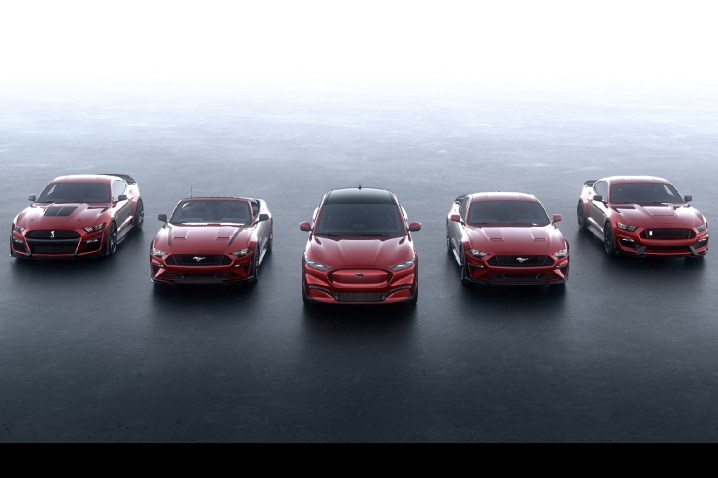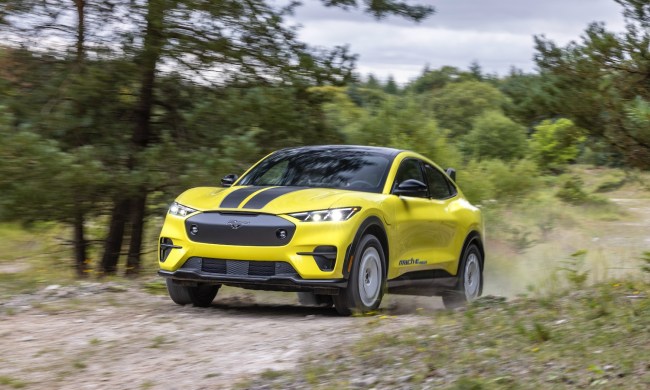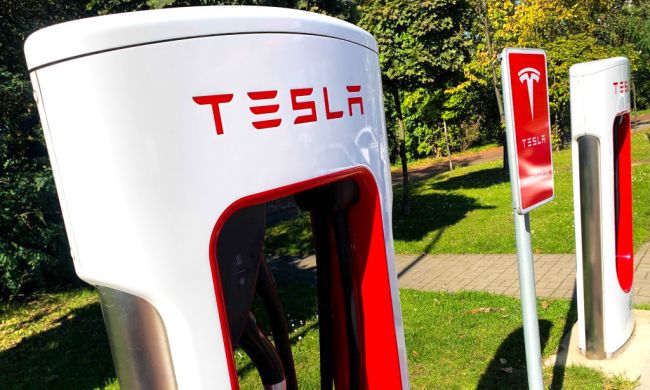
Whether you like it or not, Ford has started the process of turning the Mustang into a full family of models to capitalize on the nameplate’s decades-old popularity. Called Mustang Mach E, the first off-shoot is an electric, four-door family-hauler that slots into the crossover segment. We’re taking a look at how it stacks up against the coupe that inspired it.
Design and tech
The Mach E is Mustang-inspired, not Mustang-based, and the two models share no parts whatsoever. While the Mustang has historically been offered only as a coupe and as a convertible, the Mach E arrives as a tall, four-door crossover. The two models share a handful of styling cues such as swept-back headlights, a long hood, and triple-bar rear lights, but no one will ever mistake a Mustang for a Mach E, or vice versa. Nameplate aside, each model as its own identity.
There are even fewer parallels between the Mustang and the Mach E inside. The Mustang was developed with a focus on performance, not on tech, so the front passengers sit on seats that are lower and firmer than the Mach E’s. There’s not as much space inside, as you’d expect, but it’s still a reasonably comfortable place to travel in, and the latest update taught it how to speak tech. In contrast, the Mach E’s dashboard is dominated by a ginormous, 15.5-inch touchscreen that displays the infotainment system. There’s a second, 10.2-inch screen behind the steering wheel which replaces the instrument cluster.
It goes without saying that the Mach E is more spacious than the Mustang; it was designed as a commuter, not as a sports car, and its electric powertrain is far more compact than a V8. There’s ample space for five passengers and 29 cubic feet of trunk space, or two passengers and 59.6 cubes with the rear seats folded flat. The frunk adds 4.8 cubic feet to either figure. It’s plastic-lined, and fitted with a drain plug, so it can double as a cooler, which is — pardon the pun — pretty cool.
The Mustang carries on with the 2+2 seating layout that has characterized it since its introduction in 1964, though we wouldn’t put two adults on the rear bench and send them on a cross-country drive. Trunk space checks in at 13.5 cubes for the coupe, and 11.4 for the convertible. Both figures are actually respectable considering the Mustang’s positioning as a sports car; the coupe has a bigger trunk than a Mercedes-Benz C-Class (12.6 cubic feet).
Performance
The Mustang’s entry-level engine is a 2.3-liter four-cylinder turbocharged to 310 horsepower and 350 pound-feet of torque, though selecting the optional High-Performance Package bumps the first figure to 332. Next up in the hierarchy is the GT, which benefits from a 5.0-liter V8 rated at 460 hp and 420 lb-ft. of torque. Both engines come standard with a six-speed manual transmission, though buyers not interested in giving a shift can order a 10-speed automatic.
Want more power? You’re in luck, because Ford again joined forces with tuner Shelby to offer quicker, more exciting variants of the Mustang. The GT350 brings a 5.2-liter, 526-hp V8 to the table, while the GT500 receives a supercharged evolution of the eight tuned to a mighty 760 horsepower. Rear-wheel drive is the only layout available, regardless of transmission type, or of how many cylinders are under the hood. Ford has never sold an all-wheel-drive Mustang, though it briefly experimented with a four-wheel-drive model during the 1960s.
The Mach E is available with several different powertrain configurations, including standard- and extended-range, plus rear- and all-wheel drive. The smaller, 75-kilowatt-hour lithium-ion battery pack gives the crossover a maximum driving range of 230 miles when it’s ordered with rear-wheel drive, or just 210 miles with all-wheel drive. The entry-level model has 255 hp and 306 lb-ft. of torque, but the latter rises to 429 when customers order dual-motor all-wheel drive. And while Ford proved it could make an electric car with a stick-shift at the 2019 SEMA show, the Mach E is only offered as an automatic.
The bigger, 98-kWh battery pack unlocks about 300 miles of range in its most potent configuration. That’s with rear-wheel drive, which relies on a single electric motor rated at 282 hp and 306 lb-ft. of torque. Adding all-wheel drive bumps those figures to 332 and 417, respectively, but reduces the maximum range to 270. Finally, the performance-oriented GT offers 459 hp and 612 lb-ft. of torque and all-wheel drive at the expense of driving range, which falls to about 250 miles.
If it’s straight-line performance you’re after, keep in mind the Mach E takes 6.5 seconds to reach 60 mph from a stop in its slowest configuration, while the quickest variant does it in under four seconds. We’re told stuffing the bulky battery pack under the passenger compartment improves handling by lowering the center of gravity, but we’ll wait until we get the chance to take the Mach E for a spin to make a final call.
Pricing and availability
On sale now, the 2020 Ford Mustang carries a base price of $26,670 before a mandatory $1,095 destination charge enters the equation. That figure corresponds to an entry-level coupe with a turbocharged, 2.3-liter four-cylinder engine, and a six-speed manual transmission. The V8-powered GT starts at $35,630, while the convertible carries a base price of $32,170. It goes without saying that Mustang buyers aren’t eligible to claim tax incentives; the government isn’t about to encourage motorists to buy a sports cars. Enthusiasts don’t need to worry about the gas guzzler tax, however.
Early adopters can reserve their 2021 Ford Mustang Mach E right away by sending the company a refundable $500 deposit, but deliveries aren’t scheduled to start until late 2020. Pricing for the entry-level Select trim starts at $43,895, but eligible buyers can apply to receive a $7,500 tax credit from the federal government, so you could put a Mach E in your garage for as little as $36,395. At the other end of the spectrum, the flagship GT model starts at $60,500 before the same destination charge gets factored into the bottom line. Note that Ford hasn’t set the model’s destination charge yet.









